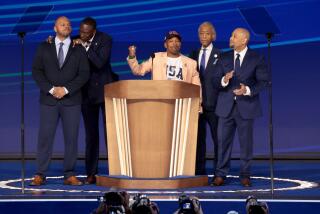Three Given Maximum Terms in Jogger Attack : Crime: Teen-agers to serve five to 10 years for assault and rape of woman in Central Park. The defense claims court proceedings were biased.
- Share via
NEW YORK — Declaring they had turned Central Park into a “torture chamber,” a State Supreme Court Justice on Tuesday sentenced three teen-agers to the maximum term of five to 10 years in prison for assaulting and raping a woman jogger.
People in New York City have the right to “freedom to walk and to be secure in their homes,” said Justice Thomas B. Galligan. The defendants, he added, had shown “no remorse, only defiance.”
He labeled as “astounding” the level of violence in the park on the night of April 19, 1989, when the jogger and others were attacked randomly by a gang of more than 30 youths. “Central Park was turned into a torture chamber by mindless marauders seeking a thrill,” the judge said angrily.
All three defendants spoke briefly, and defiantly.
Yusef Salaam, accused of striking the jogger in the head with a metal pipe, read a rap poem in which he compared himself to Nelson Mandela and Dr. Martin Luther King Jr. as a victim of white oppression
“I told the truth. I think my debt to society has been paid,” Salaam said. “This is my debt for being a black man.”
Salaam told the judge the entire court proceedings were a “legal lynching.”
“I know I was convicted of crimes me and my co-defendants never committed,” added Salaam, the only defendant to take the witness stand during the trial.
“Everybody knows I am innocent of this crime,” Raymond Santana told the judge.
Defendant Antron McCray thanked his family for supporting him. “I’m gonna make it,” he said.
Because of the seriousness of the charges, the teen-agers were tried as adults. But Galligan had to sentence them as juveniles because they were under 16 when the jogger was assaulted. If sentenced as adults, they could have received from 8 1/3 to 25 years in prison.
After 10 days of deliberations, a jury acquitted Salaam and McCray, both 16, and Santana, 15, of the top charge of attempted murder, but found all three defendants guilty of assault, rape, rioting and lesser charges.
Two of the defendant’s lawyers used the occasion of the sentencing to vehemently attack Galligan and the criminal justice system.
“This court lacks the impartiality to rule in this case,” charged McCray’s new lawyer, C. Vernon Mason. “This court was handpicked by Dist. Atty. Robert M. Morgenthau. . . . They (the teens) were tried by a lynch mob in a lynch court by a specially selected judge.”
“That is somebody’s imagination,” Galligan answered back from the bench.
William M. Kunstler, the new lawyer for Salaam, likened the court to “Alabama in 1932.”
“I am convinced what occurred here was a legal lynching,” he charged, adding that he was so sure that Galligan would impose the maximum sentence of five to 10 years that he had already filled in that sentence in forms for appeal.
“I’ll keep that in mind,” Galligan said dryly.
At one point supporters of the youths, including the Rev. Al Sharpton, a Brooklyn minister without a pulpit who has participated in numerous street demonstrations, broke into applause as the defense attorneys spoke, prompting Galligan to threaten to clear the courtroom.
Prosecutor Elizabeth Lederer asked for the maximum sentence.
“These defendants found their courage in the size of the gang,” she said. “The behavior of these defendants is a crime against our society. In the course of one hour, these defendants tried to take over a section of the city. . . . These defendants displayed no regard for human life.”
Outside the courtroom when the proceedings were over, Michael Joseph, who represented McCray during the trial, questioned the wisdom of attacking a judge when a defense lawyer is seeking a smaller than maximum sentence.
“He (Mason) is not assisting Antron McCray,” the lawyer said. “He lectured to insult the judge.”
More to Read
Sign up for Essential California
The most important California stories and recommendations in your inbox every morning.
You may occasionally receive promotional content from the Los Angeles Times.










